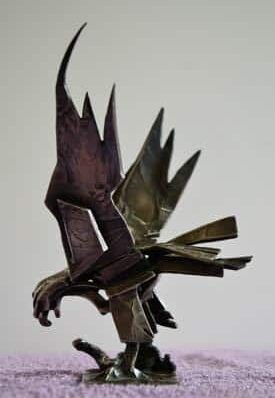“It is the same materials (and subject) but differs only line or direction whereas the other is form.”
– John Vassar House
American bronze sculptor John Vassar House (February 19, 1926 – March 29, 1982) was a well-known lost wax casting expert. American born and raised, he received his Bachelor of Arts from Harvard University in 1949 and his Master of Fine Arts from Cranbrook Art Academy in 1952. Throughout his multi-decade career, he demonstrated in bronze his artistic development and variety.
Vassar House relocated to Rome, Italy in 1957 and opened his own studio. He created the sculptural waxes that were to be cast in Italy and subsequently transported, primarily to the United States. His bronze sculptures were shown in many countries and included realistic, organic, and abstract pieces. Vassar House battled cancer but never wavered from his artistic pursuits until his death in 1982, leaving a legacy of inventiveness, commitment, and skill.
Vassar House taught at a number of schools over his career, including the University of Minnesota, the Intercontinental Club of Rome, the Overseas School of Rome, Cranbrook Boys School in Michigan, Ridley College of St. Catherine’s Ontario, and the University of Texas, Dallas.
Commemorative bronzes, substantial bronze and steel commissions, church commissions, university and museum collections, and other acquisitions dispersed throughout the United States and Italy were among the vast body of work produced by Vassar House. Of the about 250 bronzes he produced, several were models meant to be enlarged.
The transition from Figurative to Abstract and from Line Work (welded) to Cast Bronze used in the construction of John Vassar House, which will be referred to in the following paragraphs as “JVH,” does not require any additional explanations beyond the photographs that are provided below. Over the course of twenty-five years, the same proportions and motions have been reflected in equal measure. It has been brought to JVH’s attention that although the materials (and individuals) are the same, the representational result is quite distinct.
Figure 1 LINE FIGURATIVE

Photo Courtesy: PR Fueled
Figure 2 FORM FIGURATIVE

Photo Courtesy: PR Fueled
As opposed to the figurative and abstract shapes, which are both cast using the lost wax process, the Line Figurative is crafted using welded bronze. During the construction of the hollow wax full-size models, JVH is seen welding and creating them in the two side shots.
Among the very few JVH figurative sketches that were discovered, the ones that are seen here are among the extremely few. Although we do not have access to the date when these were created, it is clear that the sketched form has developed throughout time.
“Although his works are abstract and conceptual, strong and faithful to the form and character of the bronze or stone or ceramics he works with, nevertheless the attachment to reality is not lost.”
The development of John Vassar House over the course of the previous seven years is summarized in a nutshell by Judy Milske in an article that was published in the Niagara Gazette NEWS on February 2, 1964. Ms. Milske’s reply, in point of fact, encompasses the sculptural work of JVH over a period of twenty-five years.
In addition to the hawk and the eagle that are displayed above, the figurative sculptures that were cast during JVH’s professional worktime account for six of the three hundred sculptures (models and large size) that were cast.
Published by: Holy Minoza









